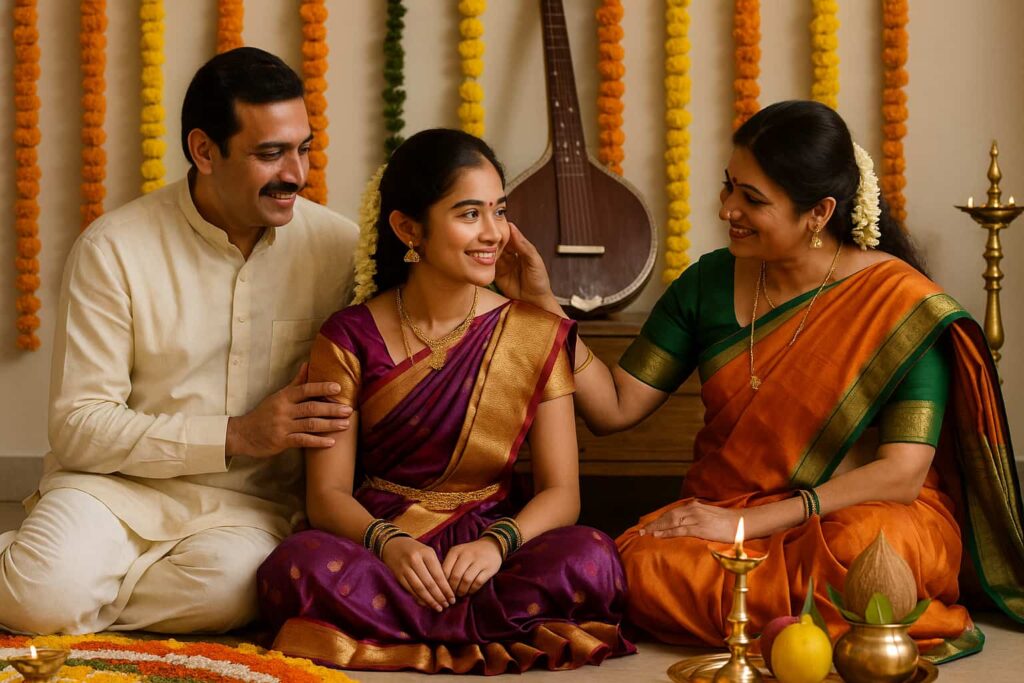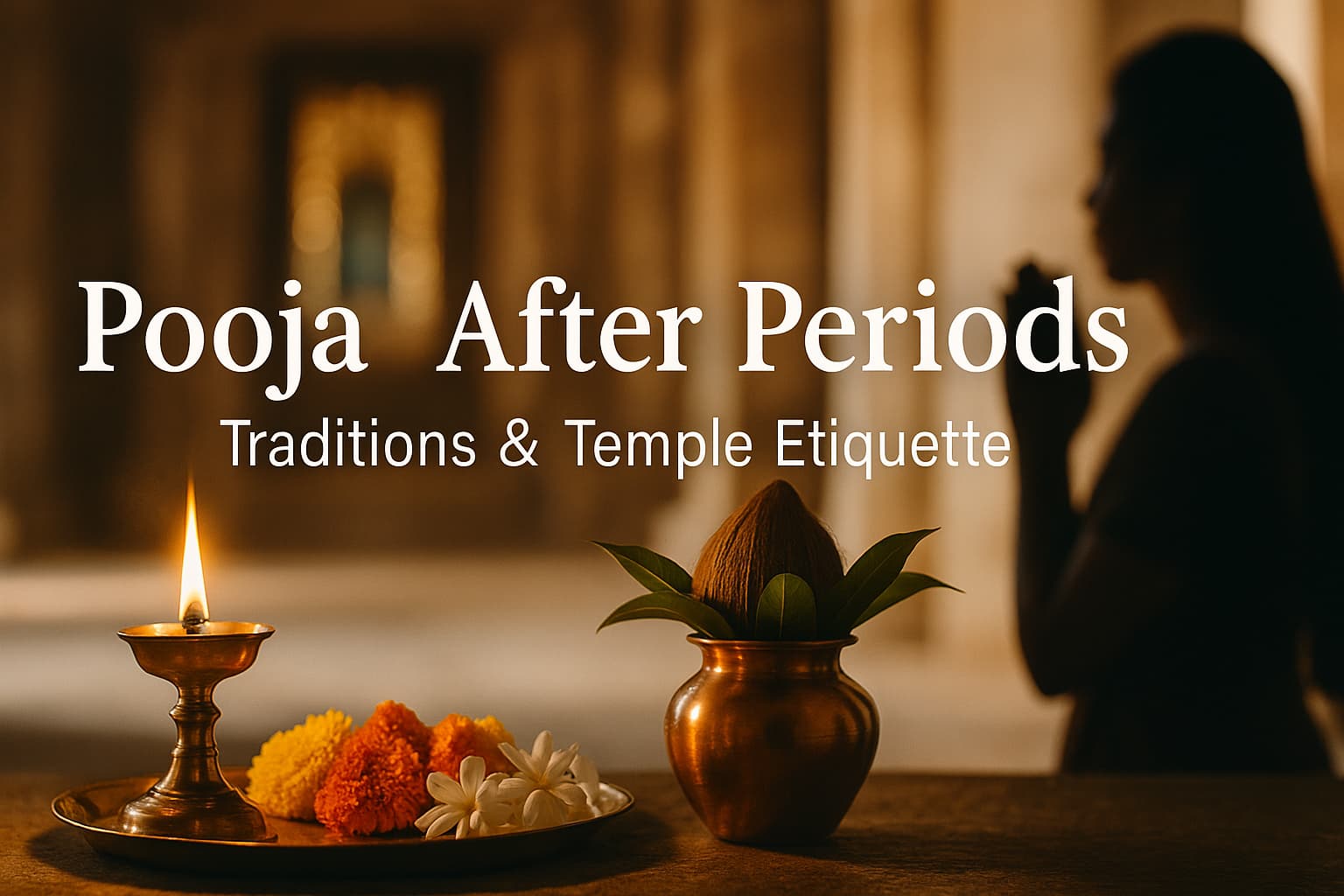Pooja after periods — “After how many days of periods can we do pooja?” This is a question many women ask, rooted in long-standing traditions and cultural beliefs. In this article, we explore the traditional customs and spiritual reasoning that guide menstruation-related practices in Hinduism, with a gentle focus on how many families and temples in Karnataka understand and follow them.
From the outset, let’s keep the tone respectful and balanced. This topic is about understanding tradition, not about shaming or judging anyone. Customs vary by family, region, and temple, and sincere devotion ultimately rests in the heart and mind of the devotee. Our aim is to explain the common patterns you’ll hear from elders and at temples so you can make a calm, well-informed choice that aligns with your family’s achara (practice) and your conscience. (Note: This article discusses customs and etiquette, not medical advice.)
Understanding “Ritual Purity” and the Sacred Cycle
The Deeper Meaning of a Sacred Rest
In many Hindu traditions, menstruation is understood as a natural, cyclical process—a time when the body focuses on cleansing and renewal. The brief pause from certain ritual activities is traditionally seen as a temporary state while the body undergoes this intense, natural process. It does not label a woman as “impure” in a negative or moral sense; rather, it recognizes a short ritual pause in the rhythm of worship.
Across Hindu custom, you’ll also find the broader concept of ashoucha—a temporary period that can follow moments of transition such as a death or childbirth in the family. The emphasis here isn’t on blame; it’s on acknowledging change and returning to normal ritual life with mindfulness. Menstruation is often placed in this same frame: a respectful rest from certain actions before fully re-entering regular pooja routines.
Seen this way, it’s easier to understand why elders may advise pausing abhishekas, temple visits, or entering the pooja room for a few days. The practice is symbolic and time-bound, cherished in many lineages and temples as part of their living tradition. For many families in Karnataka and beyond, this perspective keeps the conversation around pooja after periods anchored in respect, balance, and devotion—never in shame.
The Customary Period: The “Four-Day” Tradition
Many households—especially across parts of Karnataka—follow what is commonly called the 3–4 day rule. During this time, women often pause hands-on ritual actions such as entering the pooja room, touching the altar or murtis, offering naivedya, or visiting the inner areas of a temple. Family members may continue the daily worship while the woman takes rest. For many, this rhythm keeps the conversation around pooja after periods rooted in respect for the body’s natural cycle and the home’s lineage.
What Happens on the Fifth Day?
A widely followed custom is the snana (cleansing bath) on the fifth morning. The bath is symbolic—it marks the gentle return from a brief ritual pause to the normal flow of religious life. After the bath, women usually resume household duties and pooja as before. Some homes add a small, joyful marker at the altar—lighting a deepa, placing a fresh pushpa (flower), or offering a simple naivedya—to signify “back to routine.”
Common fifth-day steps (may vary by family):
Snana in the morning.
Fresh, clean clothes (often light/comfortable).
Altar readied by other family members beforehand (wiped, new flowers, lamp ready).
Simple upacharas (like lighting the lamp or a brief stotra).
Regular pooja routine resumes.
Note: The exact count—three days, four days, or “after bleeding stops”—does vary. The “fifth-day snana” is simply a commonly heard pattern in many homes, not a universal rule for everyone.
Traditional Practices: A Quick Reference
| Aspect | Traditional Belief |
|---|---|
| Duration of Rest | A period of 3–4 days is customary, starting from the first day of menstruation. |
| Why the Rest? | To allow the body to undergo its natural cleansing and renewal process. It is a time of ritual rest, not “impurity.” |
| When to Resume Pooja? | On the 4th or 5th day, after taking a ceremonial cleansing bath. |
| Activities to Avoid | Entering the pooja room, visiting temples, touching religious idols or sacred books. |
| Spiritual Focus | Inner devotion and meditation are encouraged as an alternative to formal rituals. |
Note: Customs vary by family and temple. Follow your family’s achara and local temple etiquette.
Beyond the Rule: Regional Differences in Practice
From Family Tradition to Temple Customs
Hindu practice is a living tradition. Customs can differ by desachara (regional practice), kulachara (family practice), and the agama followed by a specific temple. Examples you’ll commonly hear about pooja after periods include:
After the period ends + bath: Some families in Karnataka resume worship once bleeding ends, followed by a snana.
Fixed 3–4 day count: Others keep a set 3–4 day pause regardless of cycle length.
Non-ritual devotion continues: In a few homes, women continue nama-japa, listening to stotras, or scriptural reading even if hands-on rituals are paused.
Temple etiquette varies: Certain temples display notice boards asking visitors to avoid entering on particular days; others leave it to personal discretion.
Because of these differences, the best guidance usually comes from family elders and a trusted priest who knows your temple’s tradition. If you’re newly married and customs differ, ask respectfully: “Our home followed X; how is it done here?” Preserving family harmony is itself a dharmic value. Framing the conversation with empathy keeps discussions around pooja after periods grounded in respect for both tradition and personal faith.
Cultural & Spiritual Context: Ritu Kala Samskara (Langa Dhavani)
In South India—including Karnataka—Ritu Kala Samskara (also called Ritushuddhi, Half-sari/ Langa Davani ceremony) celebrates a girl’s first menstruation as a joyful rite of passage into womanhood. Families honor the moment with blessings, new clothes (often the half-saree), music, and elders’ guidance. Mentioning this ceremony offers a helpful counter-point to ideas of “impurity”: even where ritual participation pauses, the life event itself is celebrated as auspicious. Wikipedia
In Karnataka’s Temples: Etiquette on Entry
Older or more traditional temples may keep stricter etiquette about entering the garbhagriha (inner sanctum) and about pooja after periods. Many places simply trust devotees to follow their family achara; some display notice boards with guidance. Best practice:
Check the notice board near the entrance.
Ask the priest politely if you’re unsure.
When in doubt, offer pranams from outside the sanctum and visit the next day.

Connecting with God: Modern Viewpoints
In today’s world, many women manage multiple roles—careers, homes, caregiving, and community work. Naturally, perspectives on pooja after periods have broadened:
Keeping the traditional pause: Some prefer to follow exactly what elders taught, honoring the lineage’s rhythm of a brief ritual rest.
Shorter pause or “after it ends + bath”: Others resume once bleeding ends and a snana is performed, viewing cleanliness and readiness as the key.
Inner devotion continues: Many families keep the bhava (devotional feeling) alive throughout with bhajans, nama-japa, and stotra-patha, while pausing certain hands-on rituals if they wish.
The Heart of Devotion
A widely shared spiritual understanding is that bhakti resides in the heart. Rituals are beautiful pathways that support devotion—but they don’t define it entirely. In this spirit, many families hold that sincerity, cleanliness, and respect are what truly matter. This balanced view helps households choose a practice that feels both faithful to tradition and kind to the body.
Gentle note: When family views differ, a respectful conversation—“What is our home’s achara and how can I honor it?”—keeps harmony, which is itself a dharmic value.
Is It About Hygiene or Spirituality?
Historically, the pause around menstruation often aligned with practical hygiene and rest—especially in times and places without modern facilities or privacy. Over generations, this practice also gained spiritual meaning: a sacred rest that honors the body’s rhythm before re-engaging fully with ritual action.
Today, many households keep the conversation on pooja after periods balanced by combining:
Good hygiene: a cleansing snana before resuming rituals; fresh, clean clothes; a tidy altar (often readied by other family members).
Personal comfort: listening to the body; allowing rest if needed.
Spiritual intent: maintaining bhava through nama-japa, bhajans, or stotra-patha, whether or not hands-on rituals are paused.
The key is to harmonize cleanliness, respect, and sincere devotion—so the practice remains compassionate, dignified, and balanced, true to your family’s achara and your own conscience.
A Simple Guide to Resuming Pooja
Quick, respectful steps for pooja after periods:
Understand Your Family Tradition: Speak to elders and follow the custom practiced in your home. If you’ve entered a new family system, ask gently and honor their tradition.
Respect the Period of Rest: If your custom includes a pause, use it to rest and nurture your body. Even if hands-on rituals are paused, you can continue nama-japa, listening to bhajans, or reading stotras.
Perform the Cleansing Bath: If it’s part of your tradition, take a snana on the fifth morning (or when the period ends), marking your return to regular worship.
Check Temple Etiquette: If you plan a temple visit, look for notice boards or ask the priest. Respect each temple’s custom as you would a host’s house rule.
Listen to Your Heart: Ultimately, devotion is personal and sincere. Choose the approach that aligns with your faith, your family’s achara, and your comfort.
Keep Harmony First: Where customs differ in the family, aim for respectful conversation and a solution that preserves peace at home.
The Essence of Devotion
The practices around menstruation and pooja are best understood as a sacred rhythm—a short, meaningful pause followed by a grateful return to worship. Whether your home follows a 3–4 day tradition, resumes after the period ends with a bath, or focuses on continuous inner devotion with flexible rituals, the heart of the matter remains the same: sincerity, respect, and love for the Divine.
In other words, tradition offers a framework, but your intention brings it to life. Choose with awareness, act with kindness, and let your devotion—quiet or grand—be guided by respect for your body, your family, and your temple’s custom. When deciding about pooja after periods, keep harmony first and let bhakti lead the way.
Disclaimer: This article shares general information on Hindu customs and temple etiquette as commonly observed (including in Karnataka). Practices vary by family, region, and temple—please follow your family’s achara and your temple’s notice or priest’s guidance. This is not a definitive religious ruling or medical advice; for spiritual guidance consult a trusted priest, and for health questions consult a qualified doctor.

